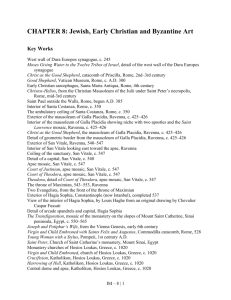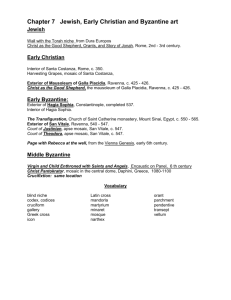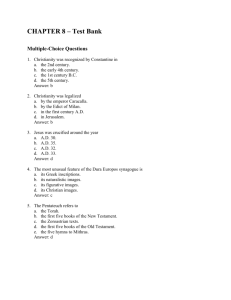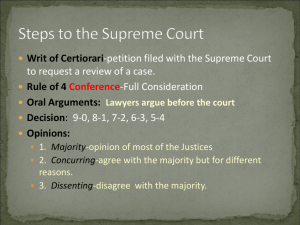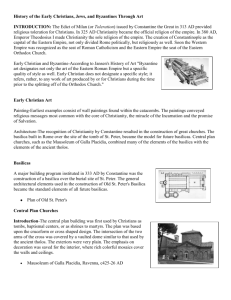CHAPTER 8 Jewish Early Christian and Byzantine Art Multiple
advertisement
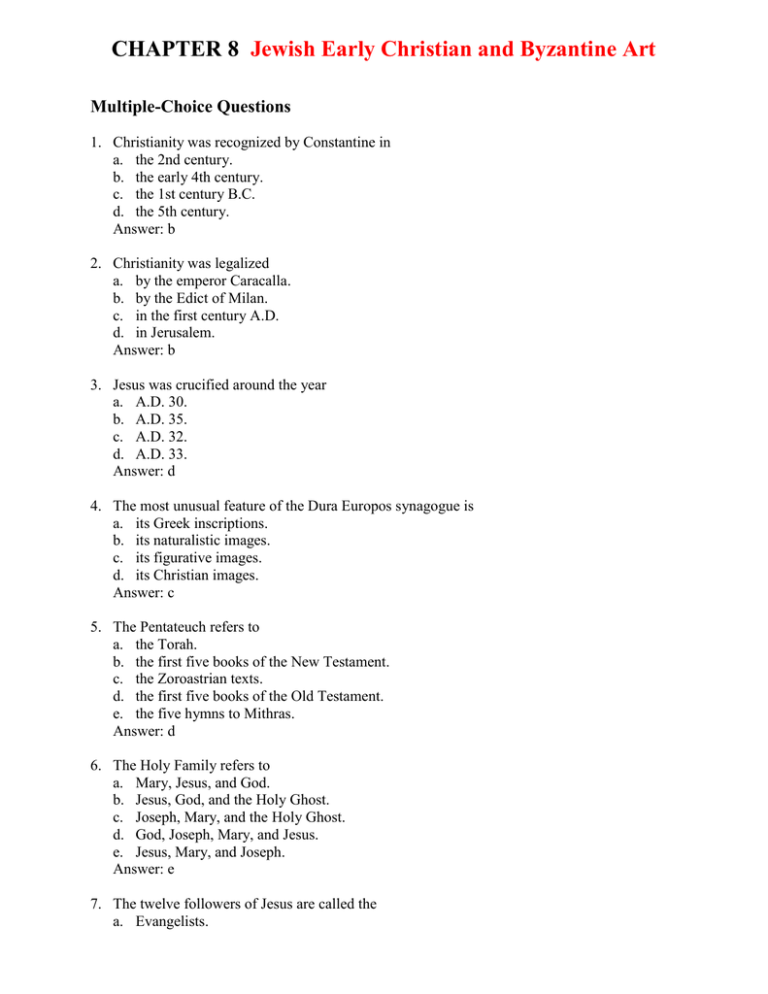
CHAPTER 8 Jewish Early Christian and Byzantine Art Multiple-Choice Questions 1. Christianity was recognized by Constantine in a. the 2nd century. b. the early 4th century. c. the 1st century B.C. d. the 5th century. Answer: b 2. Christianity was legalized a. by the emperor Caracalla. b. by the Edict of Milan. c. in the first century A.D. d. in Jerusalem. Answer: b 3. Jesus was crucified around the year a. A.D. 30. b. A.D. 35. c. A.D. 32. d. A.D. 33. Answer: d 4. The most unusual feature of the Dura Europos synagogue is a. its Greek inscriptions. b. its naturalistic images. c. its figurative images. d. its Christian images. Answer: c 5. The Pentateuch refers to a. the Torah. b. the first five books of the New Testament. c. the Zoroastrian texts. d. the first five books of the Old Testament. e. the five hymns to Mithras. Answer: d 6. The Holy Family refers to a. Mary, Jesus, and God. b. Jesus, God, and the Holy Ghost. c. Joseph, Mary, and the Holy Ghost. d. God, Joseph, Mary, and Jesus. e. Jesus, Mary, and Joseph. Answer: e 7. The twelve followers of Jesus are called the a. Evangelists. b. Prophets. c. Apostles. d. Disciples. Answer: c 8. Which is NOT a correct match? a. Baptism – John baptizes Jesus b. Nativity – Jesus’ birth c. Transfiguration – Jesus is flanked by Moses and Elijah d. Wedding at Cana – Mary and Joseph are married e. Harrowing of Hell – Jesus descends to Limbo Answer: d 9. The catacombs in Rome were primarily a. underground cemeteries. b. underground shrines. c. underground meeting places. d. underground sewers. Answer: a 10. Which is NOT a feature of the Early Christian basilica? a. nave b. apse c. aisle d. None of these answers is correct; all were features of the Early Christian basilica. Answer: d 11. The first bishop of Rome was a. Constantine. b. St. Paul. c. St. Peter. d. Eusebius. Answer: c 12. Which is NOT true of the Christian altar? a. It was originally a table. b. In most churches it is in the western end. c. It is the site of the Eucharist in the Mass. d. It often supports a Crucifix. Answer: b 13. A significant new architectural feature of Old Saint Peter’s was a. the transept. b. the nave. c. the atrium. d. the clerestory. Answer: a 14. The Roman basilica was entered from a door in its side but Old St. Peter’s in Rome was entered a. through the atrium. b. through its narthex. c. in the side of the nave. d. behind the apse. Answer: b 15. The pagan god most often associated with Christ was a. Dionysos. b. Apollo. c. Jupiter. d. Hermes. e. Zeus. Answer: b 16. “Galla Placidia” refers to a. an empress. b. a mausoleum. c. an Early Christian church. d. both an empress and a mausoleum. e. All these answers are correct. Answer: d 17. The components of Byzantine mosaics are a. pigments. b. marble squares. c. semi-precious jewels. d. tesserae. e. polished stones. Answer: d 18. Which is NOT a feature of San Vitale? a. a transept b. a narthex c. an ambulatory d. an apse Answer: a 19. Which is NOT true of San Vitale? a. It is on the east coast of Italy. b. It was the personal Church of Justinian. c. It is filled with mosaics. d. Its exterior is plain brick. Answer: b 20. The vaulted choir of San Vitale contains a representation of a. angels with Mary. b. a bust of San Vitale. c. Bishop Ecclesius. d. angels with a lamb. e. Christ as a shepherd. Answer: d 21. The dome of the Hagia Sophia is supported by a. squinches. b. pendentives. c. vaults. d. arches. Answer: b 22. A dome can be supported by a. a cylindrical drum. b. pendentives. c. squinches. d. All these answers are correct. Answer: d 23. The main Byzantine contribution to monumental architecture was a. the pendentive. b. the Composite Order. c. the dome. d. the narthex. e. the round arch. Answer: a 24. Compared with Roman frescoes and mosaics, Byzantine mosaics are a. more naturalistic. b. more narrative. c. more static. d. more three-dimensional. Answer: c 25. Which is LEAST likely to be represented in a Byzantine mosaic? a. frontality b. contrapposto c. outlined figures d. repeated poses e. flattened forms Answer: b 26. In the apse mosaics of San Vitale, a. Justinian is to the left of Christ. b. Theodora is to the right of Christ. c. Justinian is next to a baptismal font. d. Theodora is in an abbreviated apse. Answer: d 27. Justinian’s mosaic in San Vitale depicts a. soldiers, senators, Maximian, and Justinian. b. churchmen, senators, Maximian, and Justinian. c. soldiers, churchmen, Maximian, and Justinian. d. Justinian, Theodora, Maximian, and churchmen. Answer: c 28. Compared to Justinian’s mosaic at San Vitale, in Theodora’s, a. the figures are less colorful. b. there is less architecture. c. the figures are set back from the picture plane. d. the figures are all female. Answer: c 29. The ivory throne of Maximian was probably used for a. receiving dignitaries. b. royal celebrations. c. a reliquary casket. d. a ritual chair. Answer: d 30. Which feature of Hagia Sophia was NOT part of the original design? a. the dome b. the pendentives c. the minarets d. the atrium e. the narthex Answer: c 31. Dura Europos housed a. a synagogue. b. a Christian house. c. catacombs. d. both a synagogue and a Christian house. Answer: d 32. A mandorla is a. a Far Eastern chant. b. an almond-shaped aureola. c. the plan of a Hindu temple. d. a halo around the head of a saint. Answer: b 33. In Byzantine iconography, Christ is conventionally a. bearded. b. Apollonian. c. shown in contrapposto. d. shown holding a globe. e. shown in a horizontal plane. Answer: a 34. St. Mark’s in Venice shows its Byzantine influence in its a. elongated nave. b. elaborate narthex. c. insertion of a triple apse. d. dome on a centralized building. Answer: d 35. Byzantine art did NOT make a strong impact on a. Russia. b. England. c. Turkey. d. Greece. Answer: b 36. The “book with many folded skins” referred to a a. papyrus scroll. b. tablet. c. codex. d. spiral frieze. e. rotulus. Answer: c 37. Which is LEAST likely to have been illustrated in the Vienna Genesis? a. the story of Joseph and pharaoh b. the story of the tower of Babel c. the story of Moses on Mt. Sinai d. the story of the birth of Christ e. the events in the Pentateuch Answer: d 38. The narrative format of the Vienna Genesis has been compared to a. the Ara Pacis. b. the Parthenon frieze. c. the Column of Trajan. d. the Arch of Constantine. e. the San Vitale mosaics. Answer: c 39. Which best defines an icon? a. a frontal image in a church b. an image on a wood panel c. an image of Christ d. any religious image e. a purely devotional image Answer: e 40. The Iconoclastic Controversy took place in the a. 6th century. b. 7th century. c. 8th century. d. 9th century. Answer: c 41. An iconoclast is literally a. one who breaks images. b. one who believes in icons. c. one who worships icons. d. one who worships the real person instead of the icon. Answer: a 42. The tradition that St. Luke painted the Virgin was used a. to define the features of Mary. b. to support the iconophiles. c. to support the iconoclasts. d. to defend religious portraiture. Answer: b 43. One result of the Iconoclastic Controversy was a. a decline in painted images. b. a decline in mosaics. c. a decline in architectural innovation. d. a decline in sculpture. Answer: d 44. A homunculus is a. an imp. b. a devil. c. an evil spirit. d. a little man. e. a midget. Answer: d 45. Christ as Pantokrator represents Christ as a. ruler of everything. b. ruler of the world. c. ruler of heaven. d. ruler of the Church. Answer: a 46. Deësis refers to an image of a. the Holy Family. b. the Holy Ghost. c. God, Mary, and Jesus. d. Jesus, Mary, and John the Baptist. e. God, Jesus, and John the Baptist. Answer: d 47. Ichthus is an acronym for a. Jesus Christ, Savior of the World. b. Jesus Christ, Son of God, Savior. c. Jesus Christ, Son of Man. d. Jesus Christ, Son of God, Ruler of the Universe. Answer: b 48. The most important late Byzantine Russian icon painter was a. Ivan. b. Barma. c. Postnik. d. Basil. e. Rublev. Answer: e Key Works West wall of Dura Europos synagogue, c. 245 Moses Giving Water to the Twelve Tribes of Israel, detail of the west wall of the Dura Europos synagogue Christ as the Good Shepherd, catacomb of Priscilla, Rome, 2nd–3rd century Good Shephard, Vatican Museum, Rome, c. A.D. 300 Early Christian sarcophagus, Santa Maria Antiqua, Rome, 4th century Christos-Helios, from the Christian Mausoleum of the Julii under Saint Peter’s necropolis, Rome, mid-3rd century Saint Paul outside the Walls, Rome, begun A.D. 385 Interior of Santa Costanza, Rome, c. 350 The ambulatory ceiling of Santa Costanza, Rome, c. 350 Exterior of the mausoleum of Galla Placidia, Ravenna, c. 425–426 Interior of the mausoleum of Galla Placidia showing niche with two apostles and the Saint Lawrence mosaic, Ravenna, c. 425–426 Christ as the Good Shepherd, the mausoleum of Galla Placidia, Ravenna, c. 425–426 Detail of geometric border from the mausoleum of Galla Placidia, Ravenna, c. 425–426 Exterior of San Vitale, Ravenna, 540–547 Interior of San Vitale looking east toward the apse, Ravenna Ceiling of the sanctuary, San Vitale, c. 547 Detail of a capital, San Vitale, c. 540 Apse mosaic, San Vitale, c. 547 Court of Justinian, apse mosaic, San Vitale, c. 547 Court of Theodora, apse mosaic, San Vitale, c. 547 Theodora, detail of Court of Theodora, apse mosaic, San Vitale, c. 547 The throne of Maximian, 543–553, Ravenna Two Evangelists, from the front of the throne of Maximian Exterior of Hagia Sophia, Constantinople (now Istanbul), completed 537 View of the interior of Hagia Sophia, by Louis Haghe from an original drawing by Chevalier Caspar Fussati Detail of arcade spandrels and capital, Hagia Sophia The Transfiguration, mosaic of the monastery on the slopes of Mount Saint Catherine, Sinai peninsula, Egypt, c. 550–565 Joseph and Potiphar’s Wife, from the Vienna Genesis, early 6th century Virgin and Child Enthroned with Saints Felix and Augustus, Commodilla catacomb, Rome, 528 Young Woman with a Stylus, Pompeii, 1st century A.D. Saint Peter, Church of Saint Catherine’s monastery, Mount Sinai, Egypt Monastery churches of Hosios Loukas, Greece, c. 1020 Virgin and Child Enthroned, church of Hosios Loukas, Greece, c. 1020 Crucifixion, Katholikon, Hosios Loukas, Greece, c. 1020 Harrowing of Hell, Katholikon, Hosios Loukas, Greece, c. 1020 Central dome and apse, Katholikon, Hosios Loukas, Greece, c. 1020 Pantokrator, from the abbey church of Monreale, Palermo, before 1183 Christ, detail of a deësis mosaic, Hagia Sophia, 13th century Andrei Rublev, Old Testament Trinity, early 15th century Barma and Postnik, Saint Basil’s Cathedral, Moscow, 1554–1560 Maps, Diagrams, and Projections Plan of Old Saint Peter’s basilica, Rome, 333–390 Reconstruction diagram of the nave of Old Saint Peter’s basilica Cross-section and plan of the martyrium of Santa Costanza, Rome, c. 350 Plan and section of San Vitale Map of the Byzantine Empire under Justinian I, A.D. 565 Plan, section, and axonometric projection of Hagia Sophia Domes, pendentives, and squinches Diagram of an Ionic capital and the architrave Plan of the monastery churches of Hosios Loukas (after Diehl), Greece, c. 1020 Key Terms aisle ambulatory axonometric projection baptistry blind niche catacomb centrally planned clerestory cloisonné codex, codices cruciform decussis deësis diptych gable gallery Greek cross horror vacuui icon iconoclasm iconography Latin cross mandorla martyrium mausoleum minaret mosque narthex nave orant parchment pendentive polyptych repoussé screen wall squinch tessera, tesserae transept vellum Window on the World Developments in Buddhist Art (1st–7th century A.D.) Key Works Chaitya hall, Karli, Maharashtra, India, c. 50–70 A.D. Interior of Santa Sabina, Rome, 423–432 Mithuna from the façade of the chaitya hall, Karli, Maharashtra, India, c. 50–70 A.D. Preaching Buddha, from Sarnath, Uttar Pradesh, India, c. 475 The Ajanta Caves, Maharashtra, India, c. 450–500 Chaitya hall entrance, Ajanta Cave 19, Maharashtra, India, c. 450–500 Chaitya hall interior, Ajanta Cave 19, Maharashtra, India, c. 450–500 Prince Distributing Alms, Ajanta Cave 17, Maharashtra, India, c. 450–500 Padmapani, Ajanta Cave 1, Maharashtra, India, c. 450–500 Yakshī from the east torana at Sanchi, Shunga and early Andhra periods, 1st century B.C. Worship of the Buddha, Ajanta Cave 10, Maharashtra, India, c. 450–500 Colossal Buddha, Cave 20, Yungang, Shaanxi Province, China, c. 460–490 Vairochana Buddha, Longmen Caves, Hunan Province, China, 672–675 Buddha with Disciples, Pinyang Cave, Longmen, Hunan Province, China, early 6th century Vairochana Buddha, Longmen Caves, Hunan Province, China, 672–675 Maps, Diagrams, and Projections Map of South Asia Plan and section of the chaitya hall, Karli, Maharashtra, India Plan of the Ajanta Cave complex, Maharashtra, India, c. 450–500 Key Terms abhaya mudrā bhūmisparsha mudrā chaitya arch, chaitya hall crypt mithuna tribhanga veranda vihāra
